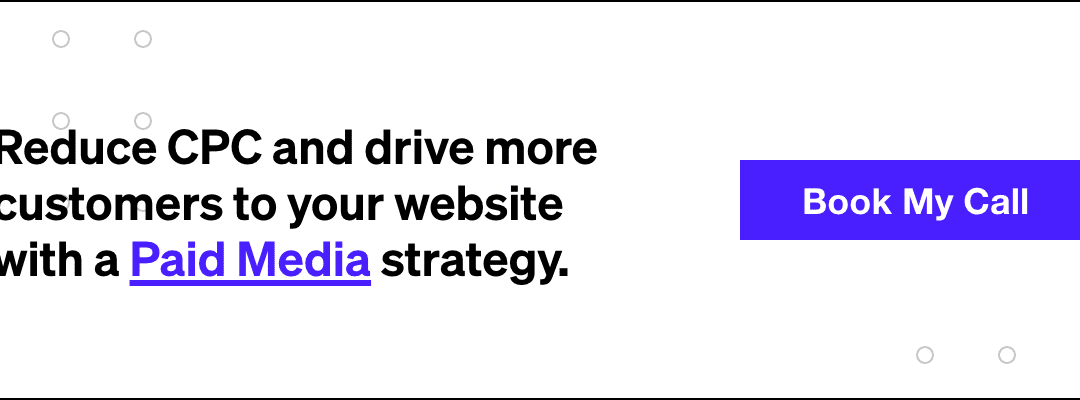Google Ads retargeting is a savvy tool for retaining consumer attention and increasing brand visibility. Since not all potential customers are ready to commit to purchasing right away, or other conversion barriers impose themselves during the customer journey, brands need a method to stay top of mind.
Retargeting does precisely that via the combination of strategic positioning and knowledge of users’ behavior—conveniently placing ads in front of potential customers who are still likely interested in a brand and its offerings. As a result, retargeting keeps potential customers interested, encourages engagement and helps drive sales.1
But what does Google Ads retargeting mean, exactly? And what are its potential benefits?
Let’s dive into the topic.
What is retargeting?
In the broadest terms, retargeting is a marketing technique that reminds a consumer of a brand’s promise, mission, products and/or services after they have expressed interest but have yet to complete an action.
Let’s put this into context:
- A user hops onto their device and visits a company’s website, social profile or mobile app. Maybe they’re performing research. Perhaps they’re conducting a price comparison on running shoes or searching for a salon’s brick-and-mortar address. Or maybe they’re just checking out the site after their colleague recommended it.
- Even though they visit a company’s web page, social profile or app, they don’t take any sort of definitive action—perhaps they abandoned those running shoes in a shopping cart or left the site after something interrupted their browsing. Regardless of the reason, the user stopped their engagement but may still be interested in your company or offerings.
- For pixel-based retargeting—a topic that will be delved into shortly—the user’s online behavior is leveraged to the brand’s advantage. Pop-up ads, banner ads and other forms of paid advertisements are displayed on the websites they visit as they continue to navigate the internet.
A retargeting campaign is intended to boost brand salience—and, ultimately, propel a consumer toward conversion. In a world that is positively saturated with businesses and their advertisements, it can be an effective means of making a lasting impression and standing out from the competition.
Why is retargeting deemed such a powerful, even necessary strategy?
Because visiting a brand’s website, social profile or app certainly isn’t the same as committing to engaging with the brand—whether that’s through a purchase or subscribing to their email list.
Indeed, data shows that 92% of prospective consumers who visit a site for the first time aren’t actually there to make a purchase.2 At the same time, MailChimp reports that an astonishing 97% of users who visit a site for the first time never return to it.3
Retargeting ads attempt to convince them otherwise and urge them back toward making a connection.
And what is Google Ads retargeting?
Google Ads retargeting is the same process as retargeting in general, only the third-party host of the paid advertisement is Google.
With Google Ads retargeting, those potential customers who ended their session before completing an action see customized ads among the results whenever they use Google’s search engine. The ad content is customized like Google’s pay-per-click (PPC) ads and based on the user’s pageviews and actions on the brand’s webpage or social platform.
This marketing initiative can be run either through Google Ads (formerly AdWords) or Google Display Ads. The latter was deemed one of the five most effective retargeting ads by Forbes, as it enables brands to reach a prospective consumer at a fraction of the cost of traditional Google Ads.4
With the former, paid advertisements follow the user wherever they go and, hopefully, nudge them back in the right direction. After all, a common refrain in the marketing world is that a consumer must be exposed to a brand five to seven times before it makes an impression that lands.5
Naturally, Google isn’t the only platform that offers retargeting. Other heavy hitters worth considering include:
- Facebook.
- Twitter.
- Instagram.
- LinkedIn.
Does all of this sound familiar? That’s because top brands ubiquitously use retargeting—which explains why checking out a pair of bamboo sheets on a website one minute results in targeted ads for the same sheets popping up the next, even on a completely different site or even on a social media app.
How does Google Ad retargeting work?
Whether a business is using Google Ads retargeting or Facebook retargeting, the strategy has two forms:6
- Pixel-based retargeting – When a user visits a site, a pixel, or piece of code, is installed on their side of the equation (unless they opt out of Cookies). This gives the business, or in this case, Google, the ability to follow where the potential customer may travel next on the internet. (It’s important to keep in mind that this is done anonymously, and no other personal data is collected or retained.) With Google Ads retargeting, Google is alerted by the pixel and displays advertisements for the business when the user visits Google Display Network websites or searches for similar terms on Google. It’s almost as if a custom audience list is automatically created based on each visitor’s activity that is then used for Google retargeting ads.
- List-based retargeting – List-based retargeting is geared exclusively to consumers who have shared their email address (or phone number), whether it’s part of a business’s existing database or because the user signed up for an email newsletter. While considerably less prevalent than pixel-based retargeting, list-based retargeting has the advantage of being able to send super-customized advertising to a consumer who seems to need only a small push of encouragement to convert.
What are the benefits of Google Ad retargeting?
As the world’s largest search engine, chances are high that a consumer will be utilizing Google as they explore the vast expanse of the internet after leaving a business’s web page or social site.
Also, as mentioned, Google Ads retargeting approaches the consumer through two angles: through advertisements on Google Display Network websites and when the user searches for related terms as they’re browsing through Google.
Specifically, the plus side of Google Ads retargeting includes:
- Cost-effectiveness – Google Ads retargeting can be substantially more budget-friendly than other forms of advertising. And since the targeted ads are directed toward a user who has already conveyed at least some interest in a brand’s product or service, it has the potential to be more effective than blindly, non-discriminately featuring advertisements widely across the internet. Google Ads also uses a pay-per-click structure, so a business will only have to pay if a consumer does click through.
- Increased brand awareness – It’s estimated that 30,000 new products are released per year—and that’s a conservative number that doesn’t take into account existing products.7 As a result, consumers are constantly—if not relentlessly—exposed to new brands on a regular basis. If a brand surfaces again as they’re reading a blog post or staying apprised of the news, it has a much greater chance of leading to conversions.
- Tailored lists – A business has the ability to craft and display ads that are perfectly aligned with the user’s behavior. Take the above example of running shoes, for example. An advertisement for the same shoes the user just browsed, as well as shoes in a different color and the right socks to wear with them, can be shown to them. This gives businesses the chance to upsell and cross-sell while still keeping costs low.
- Enriched control – Google Ads retargeting allows a company to decide who to add (and keep) on their retargeting list and how long they should be advertised to. Retargeting a customer for nine months after they visited a brand’s social profile a single time wouldn’t make much sense; a lag that long likely indicates the user has officially moved on and is no longer interested. This grants businesses the opportunity to control their advertising costs and ensure they don’t cut into their bottom line.
Is there a difference between Google Ads retargeting and remarketing?
While Google retargeting and Google remarketing may get mixed up, they are not necessarily the same. Retargeting and remarketing do, however, share several similar objectives.
That said:
- A Google Retargeting campaign utilizes paid advertising and is generally geared toward consumers who have visited a site or social profile but haven’t committed to an action.
- A Google Remarketing campaign, on the other hand, uses email marketing to ignite interest from former customers and individuals who have subscribed to their email list, newsletter and/or similar engagements. (Interested in learning more about remarketing? Leading email marketing agencies like Power Digital have the answers.)
Amplify brand awareness and enhance customer engagement with Power Digital
Google Ads retargeting can be a smart, expeditious and efficient way to lure consumers right back to where you want them: In front of your product and service, being persuaded into giving your business a try or learning more about it. Even better, with ad retargeting, you know there’s a strong chance the individual is interested in making a purchase or has already been exposed to your brand—meaning it’s a much easier conversion path than before.
So, the question is less whether you should adopt an ad retargeting strategy, and more who manages it.
You could attempt to handle all of this yourself. Or, you could keep concentrating on other aspects of your business while handing over the reins to a top-notch, tech-enabled growth marketing agency—like Power Digital Marketing, who fuses creativity with analytics to deliver optimal, measurable revenue growth.
With nova, we have the ability to determine precisely what’s working and what’s needed to help your company reach its potential, whether it’s through retargeting, remarketing, influencer marketing—you name it.
Book a consultation with us today to understand the full power of beautifully-executed Google Ads retargeting and more.
Sources:
- Forbes. What is retargeting and why is it important? https://www.forbes.com/sites/forbesagencycouncil/2020/05/20/what-is-retargeting-and-why-is-it-important/?sh=3f553c3e7212
- PR Newswire. Study: 92 percent of consumers visiting a retailer’s website for the first time aren’t there to buy. https://www.prnewswire.com/news-releases/study-92-percent-of-consumers-visiting-a-retailers-website-for-the-first-time-arent-there-to-buy-300390086.html
- MailChimp. What is retargeting? https://mailchimp.com/resources/what-is-retargeting/
- Forbes. Five effective types of retargeting ads that work on a small budget. https://www.forbes.com/sites/forbesagencycouncil/2017/12/04/five-effective-types-of-retargeting-ads-that-work-on-a-small-budget/
- Small Biz Genius. 50+ eye-opening brand statistics – 2022 edition. https://www.smallbizgenius.net/by-the-numbers/branding-statistics/
- Google Ads. What are retargeting ads? https://ads.google.com/intl/en_uk/home/resources/retargeting-ads/
- Forbes. How to launch a new product or service: what the latest research teaches us about successful launches. https://www.forbes.com/sites/shamahyder/2019/10/17/how-to-launch-a-new-product-or-service-what-the-latest-research-teaches-us-about-successful-launches/?sh=6c5c3314412a
The post What is Google Ads retargeting? appeared first on Power Digital Marketing.
Article From: "Power Digital" Read full article
 SERPCOM is a full-service Boston digital marketing agency focused on improving online visibility, increasing traffic, raising revenue and providing SEO services.
SERPCOM is a full-service Boston digital marketing agency focused on improving online visibility, increasing traffic, raising revenue and providing SEO services.
SEO-first: A fundamentally better approach to online marketing.
Digital Marketing | SEO | Web Design & Development | Search Engine Marketing

SERPCOM is a full-service Boston digital marketing agency focused on improving online visibility, increasing traffic, raising revenue and providing SEO services. SEO-first: A fundamentally better approach to online marketing.
Digital Marketing | SEO | Web Design & Development | Search Engine Marketing
SERPCOM is a full-service Boston marketing agency focused on improving online visibility, increasing traffic, raising revenue and providing SEO services for leading brands.
Maximize the value of your website and turbo charge your online marketing efforts with SERPCOM. Call or click the button and start making the web work for you.
Just click on the Phone Number to dial on your phone:





